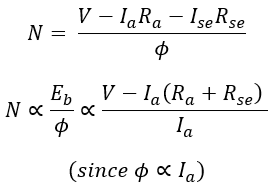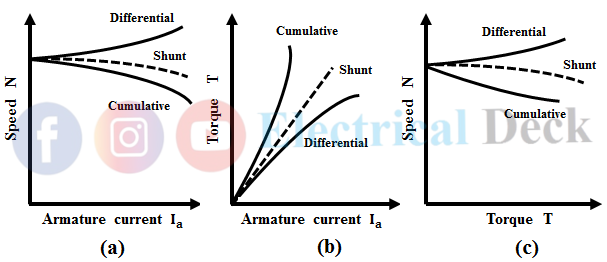Dc motors are widely used in various applications like variable-speed drives, constant-speed drives, and many more. For selecting a type dc motor for a particular application it is very important to study the characteristics of various dc motors. Dc motor characteristics give the performance under various load conditions for recommending their field of applications.
Some of the important characteristics of dc motor are,- Speed-armature current characteristics (N vs Ia),
- Torque-armature current characteristics (T vs Ia), and
- Speed-torque characteristics (N vs T).
Characteristics of DC Shunt Motor :
Speed-Armature Current Characteristics :
The equation for back emf induced in a dc motor is given as Eb = PɸNZ / 60A. From this, the relation between speed and back emf is expressed as N ∝ Eb/Φ. The expression for speed N of a dc motor is given as,
In a dc shunt motor, the field is connected across the armature terminals. Hence at constant supply voltage V, the field current remains constant producing constant Φ. But in practice due to the armature reaction effect, the distribution of air-gap flux gets distorted.
Thus reducing the resultant flux. Suppose if the load on the motor increases, the armature current Ia increases, thereby increasing the drop Ia Ra. This causes a small drop in speed because at constant Φ there will be very little change in the difference ( V - Ia Ra ) since the armature resistance Ra of a dc motor is kept very small.
The curve between speed and armature current with slightly dropping from no-load to full-load is shown in figure (a) below.
Torque-Armature Current Characteristics :
For a dc motor, the expression for torque is given as T = K Φ Ia i.e., torque is directly proportional to flux and armature current. At constant field current with constant Φ, T ∝ Ia.
Now if the load increases, the load current increases ( i.e., armature current increases ), thereby increasing the armature torque. Therefore the curve will be a straight line from the origin as shown in figure (b).
But in practice, the output torque from the motor is less than armature torque due to frictional losses at the bearings. So that in order to generate high torque, the armature current should be very high which can damage the motor. Hence the dc shunt motor is well-suited for constant speed applications like conveyors, line shafts, etc.
Speed-Torque Characteristics :
From T vs Ia and N vs Ia characteristics, the N vs T can be drawn as shown in figure (c). These characteristics are similar to speed and armature current characteristics, the speed remains almost constant for various load conditions below the full-load value.
Characteristics of DC Series Motor :
Speed-Armature Current Characteristics :
In a dc series motor, both field and armature windings are connected in series with the supply. Hence the supply voltage has to overcome the drop in the series winding also. Therefore, the expression for speed N of a dc series motor is given as,
Due to the series field connection, the field current is proportional to the armature current and hence the flux, Φ ∝ Ia. Generally, Ra and Rse are kept small ( with small Ia Ra and Ise Rse drops ), thus for constant V i.e., V ≅ Eb, if the load increases the speed decreases. The relation between N and Ia will be in the shape of a rectangular hyperbola as shown in figure (a).
It is seen that, if the load is high, Ia will be high, and speed N will be low. But at no-load condition, Ia will be low and speed N will be very high. That is why a dc series motor never allowed to start without any load connected to it or with low-load conditions.
Torque-Armature Current Characteristics :
For a dc motor, the expression for torque is given as T = K Φ Ia. In a series motor, Φ ∝ Ia, thus T ∝ Ia2. Here torque is proportional to the square of the armature current, thus curve T vs Ia will be parabolic in nature as shown in figure (b). Also the curve, the parabolic will be up to a certain limit of Ia, then after since Ia = Ise, the field winding gets saturated and produces constant flux and hence constant T (curve will be a straight line).
Therefore, from T vs Ia characteristics, a series motor when started with a load it develops high starting torque. Hence dc series motors are well suited for applications like electric trains, hoists, trolleys, etc.
Speed-Torque Characteristics :
Similar to the dc shunt motor, the N vs T relation of the dc series motor is similar to N vs Ia (a parabolic curve) as shown in figure (c). At no-load, Ia will be low, and hence torque, thus speed will be very high. As the load increases, torque increases, and speed decreases.
Characteristics of DC Compound Motor :
We know that the compound motors are made with a combination of shunt and series field windings with the armature winding. Hence the characteristics of dc compound motors will be combined characteristics of shunt and series motors. But the characteristics depend upon how the two field windings are connected.
- In a cumulative compound motor, the flux produced by the series field winding assists the flux produced by the shunt field winding.
- In differential compound motor, the series field flux opposes the shunt field flux ( reduction in resultant flux ).
Speed-Armature Current Characteristics :
The speed and armature current characteristics of dc cumulative and differential compound wound motors are shown in figure (a) below. Since resultant flux is more in cumulative compound motor with respect to load, the curve will be slightly more dropping compared to shunt motor.
Torque-Armature Current Characteristics :
If the load on the cumulative compound motor increases the torque developed also increases. But the torque decreases with an increase in load in the case of a differential compound motor as shown in figure (b).
Speed-Torque Characteristics :
When there is a sudden application of heavy loads, the speed decreases, the cumulative compound motors can develop large torque similar to series motors. At no-load, they run at definite speed due to shunt field flux, unlike series motor attain dangerous speeds.
The speed remains almost constant in differential compound motors with increases in load. Hence shunt motors are more preferred compared to differential compound motors and are rarely used.





